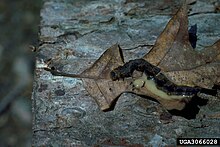Nuclear Polyhedrosis Virus
| Nuclear Polyhedrosis Virus | |
|---|---|

| |
| Virus classification | |
| Group: | Group I (dsDNA)
|
| Family: | Baculoviridae
|
The nuclear polyhedrosis virus (NPV), part of the family of baculoviruses, is a virus affecting insects, predominantly moths and butterflies. It has been used as a pesticide.
Description[]
The polyhedral capsid from which the virus gets its name is an extremely stable protein crystal that protects the virus in the external environment. It dissolves in the alkaline midgut of moths and butterflies to release the virus particle and infect the larva.[1] An example of an insect that it infects is the fall webworm.[2]
NPV was once listed by the International Committee on Taxonomy of Viruses as a subgenus of Eubaculovirinae, but the term now refers to 35 species of the family Baculoviridae—mostly alphabaculoviruses, but also one deltabaculovirus and two gammabaculoviruses.
Symptoms[]

Symptoms of NPV infection include:[citation needed]
- Discoloration (brown and yellow)
- Stress (regurgitation)
- Decomposition (liquefication)
- Lethargy (slow movement to no movement at all; refusal to eat)
The virus enters the nucleus of infected cells and reproduces until the cell begins to produce crystals in the fluids of the host. These crystals can transmit the virus from one host to another. The host becomes visibly swollen with fluid containing the virus, and eventually dies, turning black with decay.
Mortality in infected insects is nearly 100%.
Transmissibility[]

NPV is transferred from insect to insect through crystals in their bodily emissions. Because the virus is in the crystal-like capsid, it must be broken down by the alkaline digestive system of the insects to be released.
Bleach and ultraviolet light have been found to be effective in killing the virus.[citation needed]
The virus is unable to infect humans in the way it does insects, because human stomachs are acid-based and NPV requires an alkaline digestive system in order to replicate. It is possible for the virus crystals to enter human cells, but not to replicate to the point of causing illness.[3]
Applications[]
Lymantria dispar (commonly known as the gypsy moth), a serious pest of forest trees, has been successfully contained by releasing gypsy moth baculovirus (NPV) preparations. Certain species of sawfly (Neodiprion sertifer, N. lecontei, N. pratti pratti, etc.), have also been successfully controlled by NPV treatments specific to them.
Members of the genus Heliothis—cosmopolitan insects that attack at least 30 food- and fibre-yielding crop plants—have been controlled by the application of Baculovirus heliothis. In 1975, the United States Environmental Protection Agency registered the B. heliothis preparations.[citation needed]
NPV preparations have also been used commercially against pests such as Trichoplusia (under the biotrol-VTN brand name) and the cotton leafworm (under the biotrol-VSE brand name).[citation needed]
References[]
- ^ Chiu E.; Coulibaly F.; Metcalf P. (April 2012). "Insect virus polyhedra, infectious protein crystals that contain virus particles". Curr Opin Struct Biol. 22 (2): 234–40. doi:10.1016/j.sbi.2012.02.003. PMID 22475077.
- ^ Boucias, D. G.; Nordin, G. L. (1977-07-01). "Interinstar susceptibility of the fall webworm, Hyphantria cunea, to its nucleopolyhedrosis and granulosis viruses". Journal of Invertebrate Pathology. 30 (1): 68–75. doi:10.1016/0022-2011(77)90038-6.
- ^ Chiu, E; Coulibaly, F; Metcalf, P (2012). "Insect virus polyhedra, infectious protein crystals that contain virus particles". Curr Opin Struct Biol. 22 (2): 234–40. doi:10.1016/j.sbi.2012.02.003. PMID 22475077.
http://www.bio.davidson.edu/.../virusstructure.html [1]
http://www.geocities.com/rainforest/2153/np.html [2]
http://www.nysaes.cornell.edu/ent/biocontrol/pathogens/viruses.html [3]
http://www.answers.com/topic/nuclear-polyhedrosis-virus?cat=technology [4]
A Text Book Of Biotechnology by R.C. Dubey ISBN 81-219-2608-4
- Baculoviridae